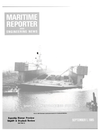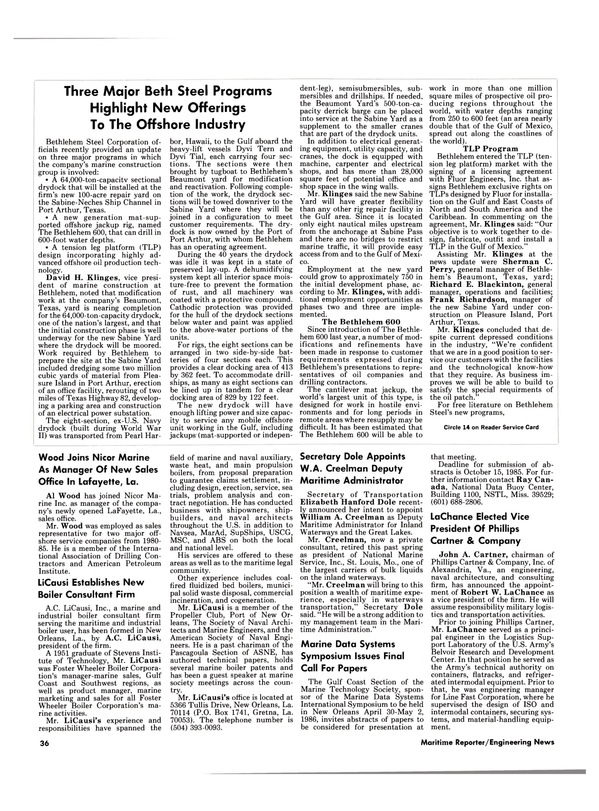
West Coast Manly Shipyards Delivers Fisheries Patrol Vessel Leonard J. Cowley
The latest addition to the Canadian Department of Fisheries and Oceans' fisheries patrol fleet, the Leonard J. Cowley, is the largest and most sophisticated vessel of her type in Canada. Operating out of St.
John's, Newfoundland, her major function will be the surveillance of the offshore fishing fleet within the Canadian 200-mile exclusive fisheries zone as far as 75° N and within Northwest Atlantic Fisheries Organization waters outside the zone.
This activity requires precise navigation, excellent boarding facilities and superior communications as well as seakindliness in all weathers, substantial capability in ice and helicopter facilities. All of these requirements are fully met. The vessel is also well equipped for search and rescue response.
Built by West Coast Manly Shipyards of Vancouver, B.C., a division of Rivtow Industries Limited, the ship's principal particulars are: gross tonnage, 2,244; displacement, 2,086 tons; overall length, 72 meters (about 236 feet); maximum beam, 14 meters (about 46 feet); and mean draft, 4.5 meters (about 14% feet).
Main engines are two 12-cylinder Polar Nohab F312A diesels, and propulsion is 3,120 kw, single-screw, variable pitch. She is classified Lloyd's 100 A.I., Ice Class 1*, LMC.
Designed by Cleaver and Walkingshaw of Vancouver, the Leonard J. Cowley has numerous innovative features, representing the leading edge of technology in navigation systems, communications, machinery, electrical monitoring and control, accommodation, helicopter facilities, maneuvering, wheelhouse design and boarding facilities.
The navigation system consists of two Sperry true motion MK-340 radars, one X Band (with a C-P antenna) and one S Band, that are fully interswitchable, combined with a CAS II ARPA, with the Channel Navigation Option. This system in turn is linked to a Sperry/TRAC IVB Qubit fully integrated navigation computer that is capable of filtering sensor information for maximum probability computations, using the INSQUA technique. This system includes high resolution color graphics, twin disc drives, a plotter, printer and a remote display.
The sensors include twin Sperry Gyros (MK227 and MK37), Magnavox 1107 RS dual channel SATNAV, INTERNAV LC 720 Loran C receiver, and a Raytheon DSN 450 dual axis doppler log.
The communications system by Navitron Communications of Vancouver includes an ITT Mackay 1-kw PEP HF/SSB radiotelephone, two Skanti 400-watt PEP HF/SSB radiotelephones, three VHF/FM transceivers, two VHF/AM transceivers, a watch receiver, an MF/HF radio direction finder, a VHF radio direction finder and radio telex facilities.
The vessel is also fitted for future installation of SATCOM and a Glenayre H.F. data terminal.
The machinery and electrical control and monitoring system is fitted to Unmanned Machinery Space requirements.
The electrical system includes 3 x 450-kw Stamford main generators powered by Caterpillar 3412 diesels and a 140-kw emergency generator with Siemens switchboards.
The ASEA monitoring and control system provides for full monitoring of all machinery systems, including shaft torque and fuel consumption. An interface to the doppler log provides for fuel consumption information based on units of either time or distance.
Modern helicopter facilities have been provided, including an aft helicopter deck and a DAF Indal retractable hangar. For navigation, an Aqua-Signal helicopter strobe beacon and VHF homing transmitter is provided. The vessel is fitted with a Brabazon fueling system that includes provisions for fuel maintenance onboard and can handle all grades of aviation fuel. Twin agent and foam systems are installed for firefighting on the helicopter deck.
For maneuvering, the vessel is equipped with a Wagner MK-6 autopilot with adaptive steering, Wagner radial steering gear, a Schilling rudder and an Ulstein bow thruster. The rudder is one of the largest of its type ever installed and is capable of being put over to 72° in either direction to produce transverse thrust. The bow thruster is a 250-hp constant speed, variablepitch tunnel thruster. The hull and machinery are reinforced to Lloyd's Ice Class 1* for operations in ice.
The wheelhouse design is unique and designed to maximize visibility in all directions. Shaped like a trapezoid with extended wings, it provides for six distinct yet interdependent workstations.
The boarding facilities are provided to meet the principal mission of the vessel—boarding offshore trawlers at sea in winds to Beaufort 7. The craft themselves are of the Watercraft RI-22 type, built by Crockett McConnell Inc. of Bridgewater, N.S., and are propelled by jet drives powered by Ford Mermaid diesel engines. The port craft is launched by a Miranda davit and the starboard craft by a HIAB 180 Seacrane.
Read West Coast Manly Shipyards Delivers Fisheries Patrol Vessel Leonard J. Cowley in Pdf, Flash or Html5 edition of September 1985 Maritime Reporter
Other stories from September 1985 issue
Content
- Tidewater Marine Acquires 5 Vessels From Otto Candies page: 5
- Hawker Siddeley/Kongsberg Collaborate In Venture page: 5
- American Air Filter Offers N e w Brochure On Cartridge Filters page: 5
- Big Supply Vessel 'Nicor Sailor' Converted By Eastern Marine page: 6
- Owen And Richards Named Managers At Honeywell page: 6
- MSC Announces FSS Award Totaling $30.7 Million page: 6
- Autronica's New NK-5 Unit Monitors Ship's Engine page: 6
- Grow Group Acquires Napko Coatings Division page: 6
- Bollinger Shipyard Dedicates Island Class USCG Patrol Boat Fleet page: 7
- Sulzer ZA40 Diesels Will Power Two Ferries Ordered In U.K. And Japan page: 8
- Cummins-Powered Construction Pushboat Delivered By Keith A. Record page: 8
- Tenneco Oil And Sohio Will Use Canmar Rig For Arctic Drilling page: 8
- Canadian Offshore Resources Exposition page: 8
- Shipboard Liquid-Level Sensor O f f e r e d By Tecnomatic Controls page: 9
- Maritime Association Installs New Officers And Directors page: 9
- Royal Cruise Line To Build Two Luxury Liners At Cost Of More Than $200 Million page: 10
- Goldstein Named Chairman Of COMSAT—Joseph Promoted To President page: 10
- Krupp MaK Consolidates In North America page: 11
- Innovative Triple-Screw Tugboat Launched By Halter Marine page: 11
- Truman Joins INDEECO As A d v e r t i s i n g Manager page: 12
- Moss Point Marine Delivers New Sternwheeler, Colonel page: 12
- Aluminum Boats Delivers High-Speed Crew/Utility Vessel To A&P Boats page: 12
- Matson Asks Bids On $30 Million Conversion of 'Matsonia' page: 14
- Brown & Root Awarded Feasibility Study Contract For Chevron Offshore Unit page: 15
- Congressional Maritime Caucus Establishes An Advisory Board page: 15
- SHIPLIFTING AND DRYDOCKING SYSTEMS page: 16
- OUTSTANDING RIG DESIGNS page: 16
- Bethlehem's Newest Jackup Design Can Drill In Water 600 Feet Deep page: 19
- Congressman To Address OMSA Meeting On Warehouse Vessels page: 19
- Alsthom Unit Strengthens Position In Norwegian Offshore Market page: 20
- Sandy Hook Dispatch Boat Delivered By Gladding-Hearn page: 20
- Saab Receives Order To Supply TankRadars From Tampa Shipyard page: 21
- Bertrem Products Importing Straub Couplings For U.S. And Canadian Distribution page: 21
- Conversion Of Fast Sealift Ship 'Regulus' Completed By NASSCO page: 22
- ASRY's 1984 Revenues Up Nearly 20 Percent page: 22
- Wartsila Wins Contract To Build Rig Transport Vessel For USSR page: 22
- E X P O S H I P Riomar85 page: 24
- Midland Ross Offers Free, 20-Page Brochure On Max-Gard® System page: 25
- Wilson W a l t o n Receives Two Contracts For Emergency Service page: 26
- Sale Of Imperial Survival Suits Approaches 100,000 page: 26
- Laursen Selected As New Managing Director Of Hemple Holding page: 28
- Owen And Richards Named Managers At Honeywell's Marine Systems Division page: 28
- CANADIAN SHIPBUILDING AND REPAIR YARDS page: 28
- Hollming Opens Louisiana Office For Marketing Aquamaster Product Line page: 29
- Two N e w Instruments To Measure C u r r e n t / V o l t a ge Introduced By Amprobe page: 29
- U.S. NAVY SHIP PROCUREMENT page: 30
- Holman and Wildasin Elected At Raymond International page: 31
- MIROS To Market New Products In U.S. page: 32
- Furuno Introduces New Low-Cost, High-Performance Loran Navigator page: 32
- NMEA Plans Expansion Of Interface Standard page: 32
- Kockums Completes Advanced Car/Truck Carrier For Wallenius page: 33
- Cincinnati Gear Completes Testing Of New, Sophisticated Marine Drive For Navy T-AO 187 Class Oilers page: 34
- New Alarm Reduces Boiler Failures, Diesel Failures And Repair Costs page: 34
- ADS Workshop Scheduled For October 2-3 In Chicago page: 35
- Seattle Yard GM Elected To Todd's Board Of Directors page: 35
- Caterpillar Offers 20-Page Catalog On Marine Diesels page: 35
- Wagner Wins $4.5-Million Contract For Steering And Control Systems page: 35
- Three Major Beth Steel Programs Highlight New Offerings To The Offshore Industry page: 36
- LiCausi Establishes New Boiler Consultant Firm page: 36
- West Coast Manly Shipyards Delivers Fisheries Patrol Vessel Leonard J. Cowley page: 36
- Free 12-Page Brochure On Marine Control System Offered By Forney page: 37
- Detroit Diesel Allison Announces Significant Engineering Advancements To Its Series 149 Engines page: 37
- Tyne Shiprepair Awarded Defence Ministry Contract To Convert Fleet Auxiliary page: 37
- Product Carrier 'Lucy' Christened At Hyundai's Ulsan Yard For Overseas Shipholding Group page: 38
- New Brochure Highlights Capabilities Of Marathon LeTourneau Offshore page: 38
- Aalborg Vaerft Awarded Danish Navy Contract For Seven Flex 300 Convertible Combatant Vessels page: 38
- McDermott Completes Twin Drilling Rig Ordered By Helmerich & Payne International page: 41
- Meyer Werft Shipyard Converts Containership Into Livestock Carrier page: 41
- Marine Drive Systems Announces N e w Shaft Systems page: 41
- N e w X-FLO Turbo Compressor Represents Major Advance In Impeller Technology page: 41
- Kockums Yard To Build Universal Ferry For Polish Shipping Company page: 41
- Transtema Kockumation Introduces New Computer System For Shipping Industry page: 41
- Huge Drydock At Bethlehem's New Sabine Yard Now Operational page: 42
- Marinette Marine Lays Keel For First Of 13 Yard Patrol Craft page: 42
- Avondale's Harvey Division Finishes Major Refurbishing Of Offshore Tug page: 44
- Meco's " T a r g a " Technology Boosts Water Maker Efficiency page: 45
- Orders A n d Deliveries Of T w i n - S c r ew Schottel-Tugs Continue W o r l d w i de page: 45
- N e w M e t h o d Of Inspection Used By Pacific M a r i ne Is Cost-Effective page: 45
- Report Shows Amerlock 400 To Be Cost-Effective Maintenance And Repair Coating page: 46
- MHI Develops Energy-Saving Marine Super Turbo Generating System page: 46
- Centurion Industrial Marine Offers The 'Crew Seat page: 47
- New Brochure Available From SKF Steel Couplings On Its OK Coupling page: 47
- New Instrument Manifold Improves Safety In Process Control Systems page: 47
- Inventive Machine Introduces Improved B l a s t / V a c u um Units page: 54
- Barksdale Controls Presents Line of Pressure Transducers page: 54
- Limitorque Introduces New Worm Gear Operators For Valve Or Mechanism Control page: 54
- Electronic Mail Techniques Save Thousands Of Dollars In Message Costs, According To NAV-COM Report page: 55
- Uniden To Introduce Six New Marine Radio Models At IMTEC Show In Chicago page: 55
- A New 12-Inch Radar From Krupp Atlas Elektronik page: 55


